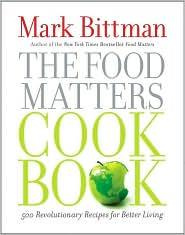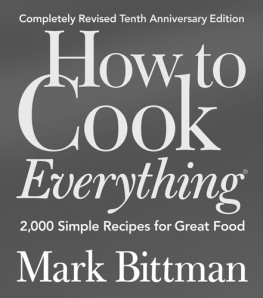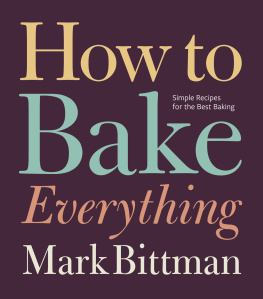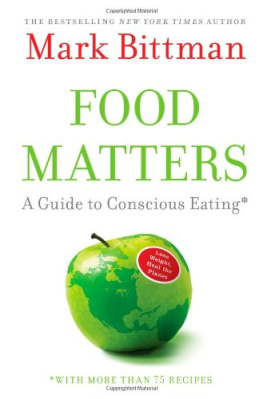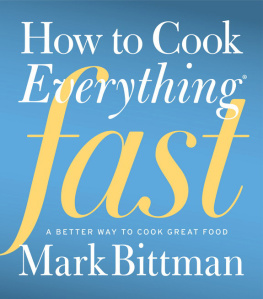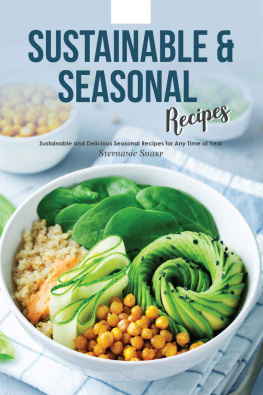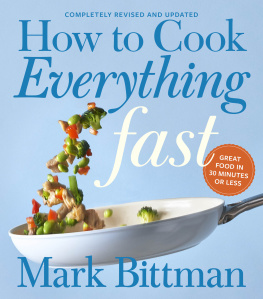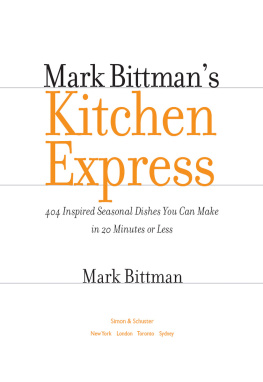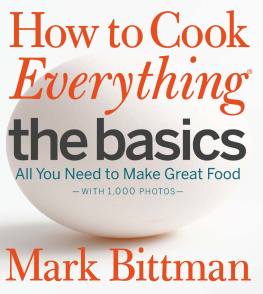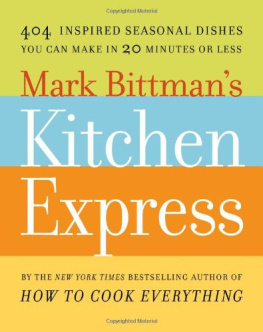
Also by Mark Bittman
Food Matters: A Guide to Conscious Eating with More Than 75 Recipes
How to Cook Everything
How to Cook Everything Vegetarian
The Best Recipes in the World
Fish: The Complete Guide to Buying and Cooking
How to Cook Everything: The Basics
How to Cook Everything: Bittman Takes On Americas Chefs
Mark Bittmans Quick and Easy Recipes from The New York Times
With Jean-Georges Vongerichten
Simple to Spectacular
Jean-Georges: Cooking at Home with a Four-Star Chef

Simon & Schuster
1230 Avenue of the Americas
New York, NY 10020
Copyright 2009 by Mark Bittman
All rights reserved, including the right to reproduce this book or portions thereof in any form whatsoever. For information address Simon & Schuster Subsidiary Rights Department, 1230 Avenue of the Americas, New York, NY 10020
S IMON & S CHUSTER and colophon are registered trademarks of Simon & Schuster, Inc.
The Simon & Schuster Speakers Bureau can bring authors to your live event. For more information or to book an event contact the Simon & Schuster Speakers Bureau at 1-866-248-3049 or visit our website at www.simonspeakers.com .
Library of Congress Cataloging-in-Publication Data
Bittman, Mark.
Mark Bittmans Kitchen Express : 404 inspired seasonal dishes you can make in 20 minutes or less / Mark Bittman.
p. cm
1. Quick and easy cookery. 2. Cookery, International. I. Title.
TX833.5.B548 2009
641.5'55dc22 2008054823
ISBN-13: 978-1-4165-7898-7
ISBN-10: 1-4165-7898-6
Visit us on the Web:
http://www.SimonandSchuster.com
CONTENTS
INTRODUCTION
The simple format of Kitchen Express belies all that it has to offer. Here are 101 incredibly fast and easy recipes for each season404 in all. The experienced home cook can play with each to great advantage, yet at their core, theyre recipes presented in the simplest form possible, understandable and readily executed by anyone whos done some cooking.
As a group, they are precisely imprecise. This is unusual for recipes, but its long been my belief that the most specific recipes are the most limiting. Specificity is fine for baking, where the chemistry among the ingredients often determines success or failure. But in savory cooking, where amounts can vary wildlytheres almost never a critical difference between one onion and two: A head of broccoli might weigh one or one-and-a-half pounds; a steak may be three-quarters to an inch and a half thickto try to force cooks to follow recipes demanding precision robs them of the ability to improvise, to relax, to substitute, to use their own judgment.
Jacques Pepin once remarked to me that the old adage about never stepping foot in the same river twice holds true for recipes also: You dont start with the same amount of ingredients, theyre not at the same temperature, theyre not the same age or from the same place, the ambient temperature and humidity are probably different, as are your equipment and mood. Everything is different, and the results will be too.
These little recipes acknowledge that up front. I dont really care how much garlic you use in most recipes, so some is as good as a teaspoon. Similarly, garnishes are garnishes: You use more, you use less, you leave them outit shouldnt matter. A carrot in a soup could certainly be a big one or a small one, and so on. So I rarely give exact measurements, unless proportions are critical.
This style of cooking is about three things: speed, flexibility, and relaxation. If you read one of these recipes, if it inspires you, and if you have the ingredients (or something approximating them) to throw it togetherthen go into the kitchen, assemble what you need, and have at it. Twenty minutes later, max, youll be eating something delicious. Whats wrong with that?
HOW TO USE THIS BOOK
There are some givens here, and its worth taking a moment to understand them. Ive organized Kitchen Express by seasons, not because I think grilling in winter or braising in summer is inappropriate, but because I wanted to feature the right ingredients at the right time. To me, the organization is not dogmatic, but it is realistic, and it jibes with the current trend among savvy eaters to avoid, for example, Southern Hemisphere fruit in winter. As it happens, asparagus is best in spring, broccoli in fall and spring, corn in summer, and so on. You can cook what you want when you want it, of course, but I think that as youre browsing in Kitchen Express, youre best off starting with the season in which you find yourself; chances are youll find something appealing right there, one that not only uses the best ingredients available but suits your mood. (When all is said and done, grilling in winter works only occasionally for those of us who have real winters, and braising in summer usually requires a pretty hefty dose of air-conditioning.)
How fast are the recipes? In general the speed with which you execute them depends not on how fast you chop (almost everyone chops better and faster than I do, and I can do any of these in 20 minutes or so) but on how well youre organized, and how well you multitask.
If youre the kind of person who organizes everything ahead of time, then spends a while chopping and assembling the ingredients, then hovers over the stove and watches everything develop, stirring and turning carefully and lovingly, thats great, but you should figure that these dishes will take you a little longer. These recipes were developed for the type of cook who gets the oil hot while chopping an onion, cooks the onion while peeling and chopping the carrot, adds the carrot and goes on to dice the meat, and so ona kind of fast, steady, sequential cooking that is more grandmotherly and short-order than it is haute cuisine.
In fact, this is definitely not haute cuisine. Its very good food, done quickly. The idea here is to provide quick, satisfying dishesdelicious dishes. Many are complete meals, but Ive often suggested appropriate accompaniments and serving suggestions to fill them out when necessary. These, of course, are optional. Most often they feature quick-cooked or pre-bought ingredients: bread, steamed broccoli, couscous. This doesnt mean that if you have time you cant make brown rice, or your own bread, or a more complicated vegetable dish.
And if you have even less time, open a jar of high-quality pickles; steam a plate of vegetables in the microwave; broil some eggplant slices; shred some cabbage or lettuce and serve the meat or seafood on that (it will wilt and collect the flavorful juices); quickly stir-fry a single vegetable in the same pan you used to cook the main course; have sliced fruit on the side; use a fast-frozen vegetable like peas, rutabaga, or corn; make a quick raw-vegetable salad by grating or chopping whatever youd like and dressing it in a little oil and vinegar. You get the idea.
By the same token, cooking methods are flexible, especially when it comes to grilling, broiling, or using a grill pan. Do what your equipment and the weather allow. In terms of equipment, I only assume that your kitchen is stocked with a food processor and probably a blender.
Generally, the quantities in the recipes here are designed for three or four people. But again, the specifications are loose enough so that it wont take much to tweak them for fewer or more servings to make a meal more substantial, or plan ahead for leftovers. You can also combine the dishes in this book to make a larger dinner or pull together a buffet; check out some suggestions on backmatter.
Next page

